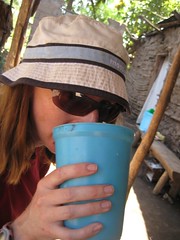Last day of safari, but not last day in Tanzania
Morning on patio at Highview Hotel
Leaving Highview and heading back to Moshi today. Supposed to tour a village for traditional food and drink.
And that’s where my journal ends.
On our last day of safari we actually didn’t go to any of the safari parks. We were a tad animal-ed out and tired of bouncing around in the truck. We had struck a deal with our guide to cut short a Serengeti day in order to spend more time in Ngorongoro Crater but that left us with nothing but a five-hour drive back to the hotel on that last day.
We had been complaining about the lack of Africa culture in our hotels so our guide set us up on one of the Cultural Tourisme Program village walking tours. We stopped at Mto Wa Mbu village just outside the Ngorongoro Conservation Area and were treated to a two-hour walk through this unique village. This is an area where the socialism experiment is working.
Over 100 tribes from Tanzania and other African countries are represented in this farmer and artisan co-op. The land around Ngorongoro is so fertile, due to the volcanic nature of the soil. There’s also plenty of water from the lakes and rainfall.
We learned about the cultivation of the different banana varieties. The bananas can’t be left to ripen on the trees because monkeys will come down and eat them, so they harvest the bananas green and put them in a ripening room with avocados, and the avocados encourage the bananas to ripen. Also, the guide said they can’t tell what kind of banana a plant will yield until it starts to flower. All this time spent in Burundi surrounded by bananas, and we hadn’t yet had the opportunity to see how they grow. Funny that we had to spend two weeks in Tanzania before we found out! We also went to a house that brews and serves banana beer. I like the Burundi banana beer better, but it was cool to see how it’s made. It’s fermented with millet, so it’s a beer I can drink!

Sampling the banana beer
We visited artist communes and were convinced to buy some wood carvings produced by a tribe that fled Mozambique. (We can get the same stuff here in Burundi, but we felt better about paying the carvers directly rather than the myriad middlemen involved with the trading.)
We also learned that the elephants from nearby Lake Manyara have developed a taste for corn, and elephants in your corn patch will obviously destroy your livelihood that season. And apparently the Masai people who raise cattle in Ngorongoro believe that all the cattle on Earth belongs to them and they’ll steal any cows that they see. So the few people in this village that have cows keep them in a spare room off of the house, to keep them hidden.
It was a fascinating tour and just what we needed after all those days of being in the car. Of course, we didn’t do nearly as much shopping and photo-taking as muzungus (white people) should. We already live in Africa and see this stuff all the time so we were bad tourists.

We visited artist communes and were convinced to buy some wood carvings produced by a tribe that fled Mozambique. (We can get the same stuff here in Burundi, but we felt better about paying the carvers directly rather than the myriad middlemen involved with the trading.)
We also learned that the elephants from nearby Lake Manyara have developed a taste for corn, and elephants in your corn patch will obviously destroy your livelihood that season. And apparently the Masai people who raise cattle in Ngorongoro believe that all the cattle on Earth belongs to them and they’ll steal any cows that they see. So the few people in this village that have cows keep them in a spare room off of the house, to keep them hidden.
It was a fascinating tour and just what we needed after all those days of being in the car. Of course, we didn’t do nearly as much shopping and photo-taking as muzungus (white people) should. We already live in Africa and see this stuff all the time so we were bad tourists.

No comments:
Post a Comment